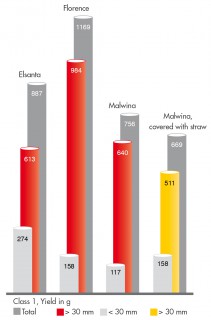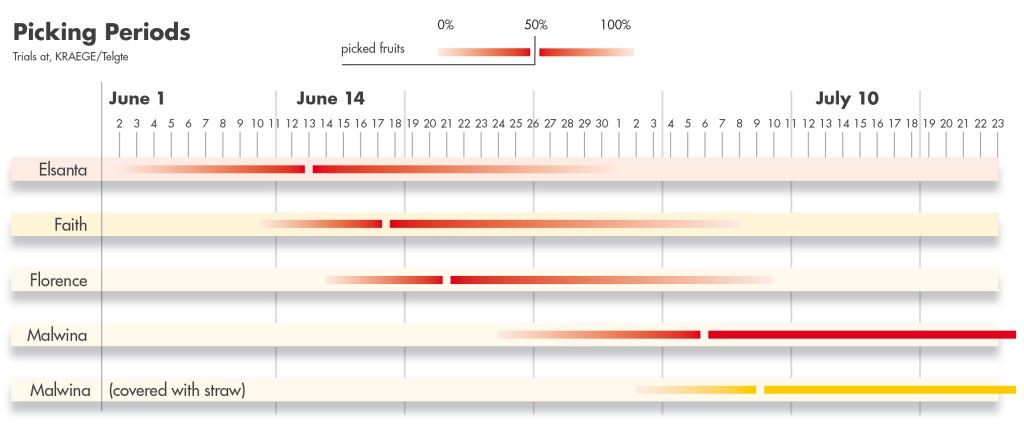| Colour | red, glossy |
| Comments | very late variety, self-fertile, the late season variety for direct marketing |
 Malwina is the latest ripening among the currently available strawberry varieties worth growing. It is setting new standards for late season varieties in direct marketing. Even under standard cultivation conditions, the medium time of harvest is 22 days after Elsanta (12 days after Florence). When straw covering is applied it ripens about 30 days after Elsanta.
Malwina is the latest ripening among the currently available strawberry varieties worth growing. It is setting new standards for late season varieties in direct marketing. Even under standard cultivation conditions, the medium time of harvest is 22 days after Elsanta (12 days after Florence). When straw covering is applied it ripens about 30 days after Elsanta.
Malwina is a crossbred of ‘Sophie’ x „Clone” (Schimmelpfeng, Weihenstefan). The crossbreeding was done in 1998 by Peter Stoppel, Kressbronn.
The plant is very robust and vigorous with dark green, medium sized, glossy leaves. Malwina blossoms underneath the leaves and is self-fertile. It is tolerant to Verticillium and is very suitable for reproduction sites.
The fruits are large, firm and feature a glossy medium red. When picked light red (wholesale
marketing), their flavor is good, while when picked fully ripe, the flavor is excellent.
Malwina is a pleasure to the eye, in the basket as well as in the punnet. Its aroma reminds us of „strawberries from grandma’s garden”, as a customer once said it. The harvest of Malwina is about 15% lower than than the ones of Elsanta (and about 20% lower when straw covering is applied). The percentage of large fruits is 85% (about 77% with straw covering). The proportion of marketable class 1 fruits is therefore higher than of Elsanta fruits.
Yet, the picking rate is 15% lower due to the short pedicels and the amount of foliage. Only when straw covering is applied, nitrogen fertilization should be taken into consideration. Wild populations should, depending on the climate and soil, only be fertilized very carefully (too much fertilization leads to a decline of the picking rate).
About 3% of the fruits feature so called „leaved inflorescences”. This genetic defect causes small leaves emerging from the fruits in about one fruit per plant.
Malwina is very hardy and resistant to diseases. For example, it is tolerant to Verticillium, very little susceptible to fruit rot and usually not affected by mildew. Malwina withstands intense rain and is little susceptible to sunburn.
Very important is a special spraying program against thrips and anthonomus rubi (strawberry blossom)!
